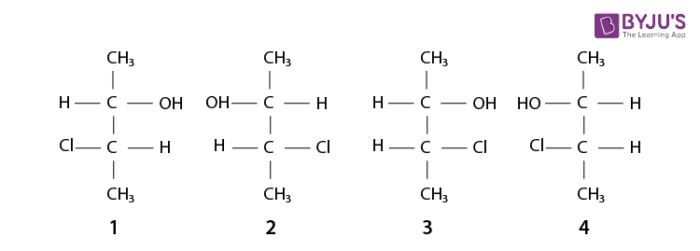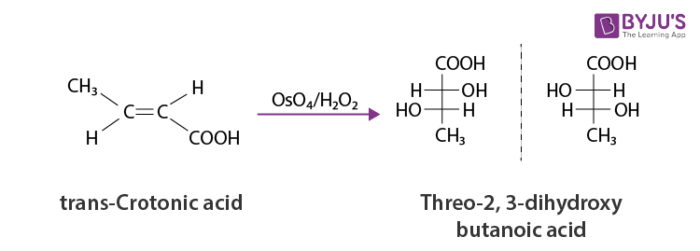What are Diastereomers?
Diastereomers are defined as compounds which have the same molecular formula and sequence of bonded elements but which are nonsuperimposable, non-mirror images.
Enantiomers and diastereomers commonly called stereoisomers fall under the broader concept of isomerism which always involves the comparison of at least two species.
Stereoisomers are molecules of identical constitution but nevertheless different. Differences between diastereomers can be expressed in scalar terms, that is by differences in the distances of certain characteristic pairs of atoms.
Table of Contents
Recommended Videos on Diastereomers
Conformational Stereoisomerism

Enantiomers and Diastereomers

Diastereomers Explanation
Stereoisomers that are not related as an object and its mirror image are called diastereomers; Diastereomers are stereoisomers that are not mirror images.
Let us consider the formula of 2,3-dichloropentane which contains two chiral centres. Now compare the two forms of 2,3-dichloropentane given below.

It becomes immediately clear that the two formulae have identical configurations about one chiral carbon C2 and mirror image configurations about the other chiral carbon (C3). The net result is that the two forms are neither identical nor mirror images of each other. Such stereoisomers of a substance that are not mirror images of each other are known as diastereomers.
3-chloro-2-butanol affords another example of a compound having two dissimilar chiral carbon atoms and can exist in four stereoisomeric forms as given below.

It may be seen that structures 1 and 3, 1 and 4, 2 and 3, 2 and 4 represent pairs of diastereomers.
Characteristics of Diastereomers
-
-
-
- Diastereomers have different physical properties such as melting points, boiling points, densities, solubilities, refractive indices, dielectric constants and specific rotations. Enantiomers have similar physical properties except the opposite sign of specific rotation.
- Diastereomers other than geometrical isomers may or maynot be optically active.
- Diastereomers show similar, but not identical chemical properties. The rates of reactions of the two diastereomers with a given reagent provided tha reagent is not rapidly active.
- On account of differences in their physical properties, diastereomers can be separated from one another through techniques like fractional crystallization, fractional distillation, chromatography etc. The difference from enantiomers which can’t be separated by these techniques.
-
-
Erythro and Threo Diastereomers
We know stereoisomers that are not mirror images are called Diastereomers. They are either geometrical isomers or compounds containing two or more chiral centres. A Diastereomer is called erythro if its Fischer projection shows similar groups on the same side of the molecule. It is called threo if similar groups are on the opposite sides of the Fischers projection.
For example, hydroxylation of trans-crotonic acid gives two enantiomers of the threo-2,3-dihydroxybutanoic acid, whereas the same reaction with cis-crotonic acid gives the erythro enantiomers.

Each pair of threo is a diastereomer of each pair of erythro isomers. The terms erythro and threo are generally used only with molecules that do not have symmetric ends.
Properties of Enantiomers and Diastereomers
Enantiomers have identical chemical and physical properties, except for their optical rotation. In comparison, the diastereomers have different physical properties and sometimes different chemical properties also. The following table shows the similarity and differences of properties of enantiomers and diastereomers.
The comparison of the properties of enantiomers and diastereomers are
| S.No | Property | Enantiomers | Diastereomers |
| 1 | Melting point | Identical Melting point | Different Melting point |
| 2 | Boiling point | Identical Boiling point | Different Boiling point |
| 3 | Solubility | Same | Different |
| 4 | Optical rotation | Same, but opposite sign | Different values may have the same or opposite sign |
| 5 | Chemical properties | Similar | May be different |
| 6 | Free energy | Same | Different |
Frequently Asked Questions on Diastereomers
What is the difference between an enantiomer and a diastereomer?
Enantiomers and diastereomers are two types of stereoisomers. Enantiomers include mirror images and non-superimposable chiral centers. Diastereomers contain non-superimposable chiral centers, but are not mirror images. Depending on the number of stereocenters, there could be far more than 2.
What are diastereomers as an example?
Diastereomers may often include compounds which are ring structures. Imagine, for example, two compounds with a six-membered ring, each with two substituents, a chlorine atom and an ethyl group. They are also not mirror images of each other, just like our previous example, which defines them as diastereomers.
Are enantiomers optically active?
Yes. All enantiomers are involved with optical effects. Optical behaviour is also one of the concepts of enantiomers because enantiomers are molecule isomers which are non-super-imposable mirror images of each other and rotate light in opposite directions.
Are diastereomers always chiral?
Diastereomers are often chiral and distinct from each other. Remember that pairs of diastereomers exist, and each has two chiral centres. The chirality of one of them would be (for example) “R, S” in the original classic diastereomer, and the other would be “R, R.”
Which are two types of stereoisomers?
Diastereomerism (including ‘cis-trans isomerism’) Optical Isomerism (also known as ‘enantiomerism’ and ‘chirality’) are the two primary forms of stereoisomerism.
Are D and L enantiomers?
The enantiomers D and L refer to the molecule’s configurational stereochemistry. L isomers have the hydroxyl group positioned on the left side of the carbonyl asymmetric carbon furthest, while D isomers have the hydroxyl group on the right side.
How do you identify diastereomers?
If there is more than one chiral center in a molecule, you have the risk of making stereoisomers not mirroring each other’s images. These stereoisomers are called diastereomers, which are not mirror images. Typically, diastereomers can only be detected when the molecule has two or more chiral centres.



Comments